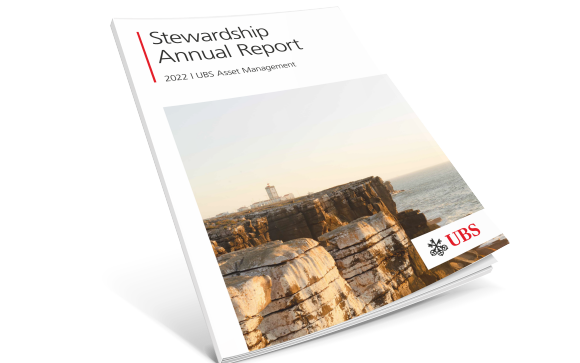Securing a sustainable food supply
Investors, consumers, policymakers and scientists must work together to balance a more productive global food system while reducing natural resource inputs.
If they do not, we are unlikely to be able to address food security in a sustainable manner, argues UBS Asset Management Real Estate & Private Markets’ Head of Food & Agriculture Darren Rabenou, Head of Sustainability Olivia Muir and Food & Agriculture Sustainability and Research Analyst Manisha Bicchieri.
As global climate concerns intensify, world food insecurity remains. Despite a goal of Zero Hunger as part of the UN 2030 Sustainable Development Agenda, the first material increase in the percentage of the world population that is undernourished occurred in 2020 and has continued to increase since.
According to the UN Food and Agriculture Organization (FAO), this “dispel[s] any lingering doubts that the world is moving backwards in its efforts to end hunger, food insecurity and malnutrition.”1 With food security – or lack thereof – firmly back at the top of the global agenda, the world’s agricultural sector must balance the need for an increased food supply while decreasing natural resource demand.
The demand side: consumption and waste
The demand side: consumption and waste
In addition to increased food demand due to global population growth, wealthier populations are demanding more meat and other animal products. As a result, there is increasing need for feed crops as well as food crops. Alas, the expansion of land for agriculture is the leading cause of deforestation, with much of this land cleared to grow crops and raise livestock.
There is increasing need for feed crops as well as food crops.
Investors, companies, policymakers and scientists must support alternative protein adoption by consumers as a means to reduce land use pressures for feed crops and minimize deforestation impacts. Moreover, consumer shifts to food products with lower land use intensities, such as plant-based and/or cultivated protein alternatives, has the potential to result in a material reduction in the agricultural sector’s greenhouse gas emissions. The sector currently contributes approximately 30% of global emissions,2 with beef and dairy cattle estimated by the UN FAO to be responsible for more than half of the sector’s overall emissions.3
Another demand pressure that results as countries develop is food loss and waste. According to the World Resources Institute, one-third of all food produced globally by weight is lost between farm and fork.4
In developing countries, food losses typically happen earlier in the supply chain as a result of production, storage, processing, and/or distribution issues. Investments in the improvement of infrastructure and technology, including more available and efficient cold storage solutions, are critical to reducing this type of food loss. In developed countries, food waste most often occurs at the retail and consumer end of the supply chain. Adapting consumer preferences and changing consumer behavior through advocacy and education from scientists and policymakers alike can help to curtail food waste in stores and homes.
The supply side: producing more with less
The supply side: producing more with less
To meet increasing global food demand while abating the climate crisis the world now faces, we must also make supply side improvements. This includes continued increases in land productivity with less natural resource inputs. Investments in the development and distribution of precision agriculture science and technology – that is, the improvement of crop yields through effective management of irrigation strategies, crop protectant applications and fertilizer inputs – are critical to achieving this balance and ensuring long-term food security.
Agriculture uses 70% of the earth’s freshwater resources,5 with flood irrigation – the most water intensive method of irrigating crops – widely utilized by farmers globally. Though irrigated agriculture is, on average, at least twice as productive per unit of land as rainfed agriculture,6 flood irrigation wastes approximately 50% of the water applied.7 To address climate concerns regarding rising temperatures and prolonged drought, investors, companies, policymakers and scientists must work to advance irrigation technology that is economical and energy efficient, particularly in developing countries where flood irrigation is principle.
70% of earth’s freshwater resources are used for agriculture.
In addition to irrigation improvements, the advancement of crop protectants and fertilizers has resulted in significant increases in crop yields, helping to provide the world a diet of healthy and affordable food. However, excessive use of these inputs has been detrimental to the environment and society. In fact, nitrogen fertilizers represent one of the largest sources of greenhouse gas emissions from global agricultural production. Their overuse has resulted in significant emissions of nitrous oxide, a persistent greenhouse gas with 265 times the climate impact of carbon dioxide.8
While continued crop productivity gains are necessary to meet the world’s increasing demand for food, judicious use of irrigation, crop protectants and fertilizer inputs is necessary. When combined with effective technology development and integration, precision agriculture can lessen negative production impacts and reduce unnecessary resource use.
Conclusions and actions
Conclusions and actions
The urgency to address the global climate crisis has never been greater. It demands reform of our use of natural resources across all industries, with the food and agriculture sector of top concern.
Paradoxically, while agriculture is a major contributor to this crisis, it is also one of the most affected sectors. Thus, meeting the increased demand for food from a larger and wealthier population combined with limited land and finite natural resource supplies requires the participation of all stakeholders – investors, companies, consumers, policymakers and scientists alike – in order to secure a global sustainable food supply.
About the authors

Olivia Muir
Head of Sustainability for Real Estate & Private Markets (REPM) at UBS Asset Management
Olivia Muir, Head of Sustainability for Real Estate & Private Markets (REPM) at UBS Asset Management. Responsible for sustainability capabilities, processes, and promotion across all business areas in REPM. Former Portfolio Manager in REPM's MMRE platform, overseeing European and UK investments. Olivia led MMRE's sustainability activities since 2015. Joined UBS-AM in June 2011, where she worked in the direct real estate team. Olivia Sits on REPM Management Forum, GRESB's Real Estate Standards Committee, and PRI Real Estate Advisory Committee.

Darren Rabenou
Head of ESG Investment Strategies and Head of Food & Agriculture
Darren Rabenou is the Head of Food & Agriculture at UBS-AM Real Estate & Private Markert's Division. He oversees the UBS Farmland business and other food-related investment strategies. Darren serves on the investment committee for UBS’s food cold storage development strategy and represents REPM on the Sustainable Finance Committee. He has over 30 years of investment experience and before joining UBS, Darren was a partner at Fabbri Group, Managing large-scale farmland operations in California and Portugal.

Manisha Bicchieri
Sustainability and research analyst
Manisha Bicchieri is a sustainability and research analyst for farmland at UBS-AM Real Estate US division. With over 6 years of agricultural finance and investment experience. She manages ESG initiatives and implements leading harvest farmland management standards. Manisha has worked with Farm Credit East, Manulife investment management, and the Rohatyn group. She holds a BSc in resource Economics, focusing on environmental economics and policy, from the University of Connecticut, along with a minor in agribusiness management and food science.

PDF
The Sustainable Investing Edition
The Sustainable Investing Edition
The special edition of Panorama is dedicated to sustainable investing and places a marker in the ground for where we should all head next.
Was this article helpful?
Please enable javascript in your browser and retry.
The feedback component cannot be displayed.
Make an inquiry
Fill in an inquiry form and leave your details – we’ll be back in touch.
Introducing our leadership team
Meet the members of the team responsible for UBS Asset Management’s strategic direction.






